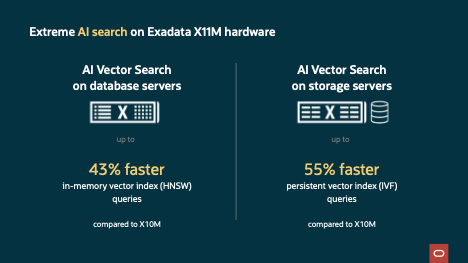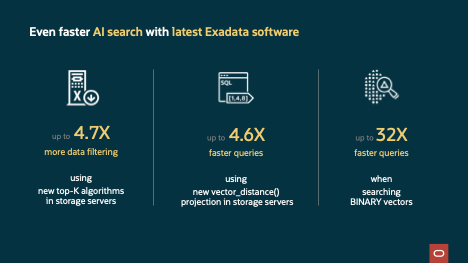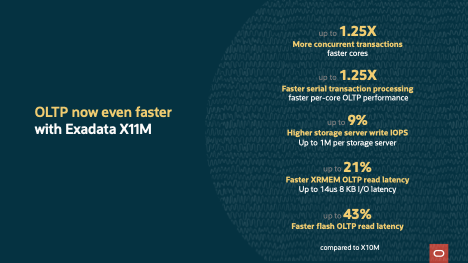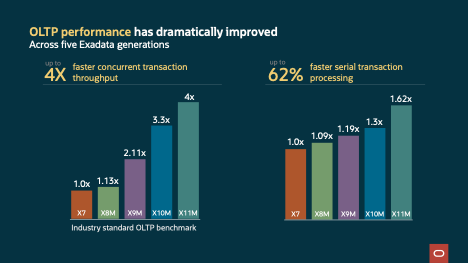We’re thrilled to announce the launch of X11M, the next generation of the Exadata platform on Oracle Cloud Infrastructure (OCI). This game-changing, intelligent data architecture delivers extreme performance to elevate your AI, OLTP, and analytics workloads. Let’s talk about what Exadata X11M means for the Autonomous Database on Dedicated Exadata Cloud Infrastructure.
Oracle Autonomous Database on Dedicated Exadata Cloud Infrastructure
Just to make sure we’re all on the same page, let’s start with a quick overview of the Autonomous Database (ADB). The Autonomous Database is an Oracle Database, deployed with either Oracle 19c or 23ai on Exadata, the world’s most optimized platform for running an Oracle database. Powered by AI and machine learning, it allows Oracle to make decisions on how to optimize performance, security, resource efficiency, availability and other aspects of the database. And because Oracle’s distributed cloud meets you where you’re at, we offer Autonomous Database in OCI as either Autonomous Database Serverless (ADB-S) or Autonomous Database Dedicated (ADB-D), on Exadata Cloud@Customer, in Oracle Dedicated Regions, and even in other cloud providers through our multicloud partnerships, Oracle Database@Azure, Oracle Database@Google Cloud, and Oracle Database@AWS.
Now for the purpose of this blog, we’ll focus on Autonomous Database (ADB-D) deployed on Exadata Cloud Infrastructure X11M.
Feature Differentiators Between X11M and X9M
|
|
X11M |
X9M |
| Elastic Compute |
5th Generation AMD EPYCTM Processors |
3rd Generation AMD EPYCTM Processors |
| Up to 6,080 Usable Database Server Cores Available to VMs |
Up to 4,032 Database Server Cores Available to VMs |
|
| Scalable Storage |
Up to 4.0 PB Database Size (High Redundancy, Without Compression) |
Up to 3.1 PB Database Size (High Redundancy, Without Compression) |
| Fastest Networking |
100 Gbps RoCE Internal Fabric AND 50 Gbps Ethernet shared for client and backup connections |
50 Gbps Ethernet shared for client and backup connections
|
With X11M, you’re getting even more and faster CPU cores, faster DDR5 memory, and faster PCle NVMe flash. With these improvements alone, you’ll experience performance like you’ve never seen before. However, one new addition is the Exadata Remote Direct Memory Access (RDMA) Memory (XRMEM). XRMEM facilitates ultra-fast data transfer between the database nodes and storage servers significantly reducing latency and CPU overhead and enhancing the efficiency of data access. XRMEM was introduced in Exadata X10M, but it’s the first time you’ll be able to use it in the cloud.
In addition to the increase in specs for the Exadata Hardware, major updates have been made to the Exadata Software. One unique feature I want to highlight is AI Smart Scan which greatly accelerates AI Vector Search with optimizations that deliver extremely low-latency, high-throughput, and parallelized scans across massive volumes of vector data. To learn more about the capabilities of X11M, please refer to this data sheet.
Aside from these technical improvements from Exadata X9M to X11M, another difference is that X11M will only be supported in the ECPU compute model. Originally rolled out last year with the Autonomous Database and the Exadata Database on Exascale Infrastructure, the ECPU is a hardware generation agnostic unit of compute that will simplify database cloud consumption and is based on the number of cores elastically allocated from a pool of compute and storage servers. This hardware version-agnostic billing metric approach helps Oracle provide consistent, optimized resource allocation and pricing across different hardware generations. It also greatly simplifies the price list because there won’t be a different set of SKUs for every generation of hardware For more information, check out our ECPU FAQ page.
The minimum entry for Dedicated Exadata Cloud Infrastructure will still be the Base System, but if you want flexibility and Exadata MultiVM capabilities, the lowest entry will be 2 database and 3 storage servers, which in X9M and prior generations was known as a “quarter rack.” The minimum system is then expandable using service APIs, adding independently up to 32 compute and 64 storage servers. And as for the cost, X11M is priced exactly the same price as X9M! Even though you get all the technical improvements I mentioned above, you don’t pay a penny more! It’s a win-win: you get advanced features and improved efficiency, all without breaking the bank. By upgrading to X11M, you’ll not just be keeping up with the competition, you’ll be getting ahead, all at an unbeatable value.
Performance Comparison Between X11M and X9M
X9M is already a super-fast Database Cloud Platform, but X11M is a marked improvement. It’s wild to think that could get even faster with X11M. But we did. Take a look at the performance improvements for your AI Search, OLTP, and analytics workloads





We’re continuously improving our Exadata platform for the everchanging priorities of our customers and providing more bang for the buck!
Why Autonomous Database on Exadata Cloud Infrastructure X11M
So now that we’ve seen what Exadata Cloud Infrastructure X11M brings to the table, let’s talk about how these improvements benefit the Autonomous Database. As I mentioned before, you can deploy the Autonomous Database on Dedicated Exadata Cloud Infrastructure, and if it were up to me, I’d definitely choose the X11M! You have the flexibility to organize your VMs (and databases) however you see fit because this Exadata infrastructure is dedicated to you for your use only. And you could set up a VM Governance model (VMs for Dev, UAT, Prod, etc.) that supports Self-Service of Autonomous Databases which would, effectively, create your own dedicated ADB Serverless environment, but with added software change management controls for that operational flexibility. By allocating quotas for different Lines of Business (LOBs) or projects, you can prevent over-utilization, enhance security, and improve budget tracking. Also, if you’re already an ExaDB-D customer and looking to upgrade to X11M, you’ll have spare capacity to simultaneously run the Autonomous Database on that same infrastructure using our Multi VM capability. This consolidation of Exadata Database and Autonomous Database on the same physical infrastructures the best way to maximize the value of your infrastructure investment.
Now let’s talk a little bit more about the cost savings you’re going to get with Autonomous Database Service. You get true Pay-Per-Use with billing since ADB is billed by second of CPU usage instead of being based on the configuration of CPUs in the VM allocation which may be idle and not processing database queries at any given time. So, you really do get to only pay for what you’re using when you use it. Plus, you’ll also get additional savings from features like auto-scaling and elastic pools, which are exclusive to ADB, and can lead to 87% compute savings.
But not only are you saving money on Autonomous Database Service CPUs, but with ADB, you can lower your Total Cost of Ownership (TCO) by letting Oracle handle database maintenance and management. Database, operating system, hardware firmware, infrastructure networking security patches all happen “automagically.” No more worries about downtime, testing your rolling patch apply procedures, manually fixing broken standbys, monitoring the alert logs or trace file or any of those kinds of administrative activities! With all that free time, you’re able to elevate your “OpsDev” to “DevOps 2.0” where you focus on supporting developer innovation while Oracle handles the Ops monotony. Like I mentioned before, ADB is a scalable, self-managing, highly available intelligent data platform that takes little to no operational effort to provision or maintain. Now you have all of this time to innovate and move your organization to a position of competitive advantage.
What kind of innovation might you drive now that you’ve taken advantage of the benefits of Autonomous Database on Exadata Cloud Infrastructure X11M? Well, let’s use the example of an AI workload since it’s AI is such a hot topic right now. Until now, relational searches have primarily relied on literal equality, where the results are based on exact matches or direct comparisons between data points. This method is limited in its ability to capture nuanced relationships or interpret context, and requires rigid, predefined parameters. As a result, the scope of such searches can be narrow and less flexible. But with Autonomous Database on Oracle Database 23ai with its native AI Vector Search capabilities, this traditional approach is revolutionized. AI Vector Search allows for more intelligent, context-aware search results by leveraging database vectors to understand the semantic meaning within the data, rather than relying solely on literal matches. You’ll get more accurate, relevant, and flexible insights, even with unstructured data or complex queries.
A great example of this is if you’re looking to adopt a dog (hashtag adopt don’t shop) and you want it to look just like your childhood dog, but you have no idea what breed it was, and you have a picture. With a literal search, you would need literal values like its breed, weight, etc. But if you were using Oracle 23ai AI Vector Search your childhood picture could be compared to all adoptable dogs to identify the dog that most reminds you of your childhood pet regardless of breed. And then, because Oracle 23ai isn’t just a vector database, you can join those results with other criteria like if they’re good with cats, potty trained, and other things you’re looking for in your future dog. And, voila, you’re able to find and adopt your dream dog all thanks to AI Vector Search!
So, whether you’re using it adopt a dog or using it in a business setting to identify similar themes in customer service chats, your sales inventory, or anything else you can think of, you want to make sure you’re getting the best performance possible. With AI Smart Scan in X11M, you can automatically accelerate Oracle Database 23ai AI Vector Search by leveraging XRMEM and Exadata Smart Flash Cache, avoiding unnecessary network data transfer and database server processing, getting you that premier performance.
Again, it doesn’t matter the workload, Exadata X11M is going to give your Autonomous Database the best possible performance and enable your business to operate more effectively, adapt to changes, and create value for your customers and employees.
Get Started Today
See first-hand how Oracle Autonomous Database reduces the complexity of operating Oracle Databases while giving you the highest levels of performance, scalability, and availability. If you’re already subscribed to Exadata Cloud Infrastructure, you can try Autonomous Database at no extra cost with Autonomous Database Dedicated Developer. But don’t worry if you don’t, you can always try out Autonomous Database with Oracle LiveLabs, a free of charge service where you can learn technical skills without creating an account or Oracle Cloud tenancy, and once you feel ready to explore Oracle Cloud Infrastructure, get unlimited services like Autonomous Database with the Always Free Tier.